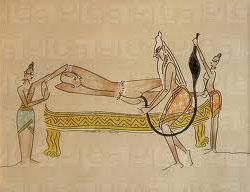
The Purification Procedures
Panchakarma is the group of five fold treatments, all of which are not commonly practised in all diseases. The panchakarma therapies include vamana, virechana, vasti ,nasya and raktamokshana. Vamana is emesis, virechana is purging, vasti is enema, which of two kinds done with medicated oils and medicated decoctions and is called snehavasti and kashayavasti respectively, Nasya is instillation of medicines through nose, and raktamokshana is blood-letting. All the panchakarma procedures are to be performed under the supervision of an experienced qualified physician only.
Objectives of Panchakarma:
To loosen the toxins
To eliminate the vitiated elements that are the cause for the disease.
1. Vamana - Use of Emetics
This therapy is mainly used in cases of chronic disorders due to Kapha dosha. It involves induced and controlled vomiting with the help of medicines. Vamana should not be given to the very young or the very old or during pregnancy.
2. Virechana - Use of laxatives
This therapy is mainly used in cases of chronic disorders due to Pitta dosha. It involves induced and controlled purgation with the help of medicines. Virechana should not be given to the very young or the very old or during pregnancy.
3. Vasti - Medicated Enema
Involves administering medicines through anal orifice.
The medicines used can be decoctions, pure / formulated oils,
milk etc. It is used to cure arthritis, backache etc.
4. Nasya - Nasal administration of medication
Nasya is administered through the nose. Medicated powders, decoctions or oil drops are introduced into the nasal passages. They remove residual doshas and toxins from the head and neck area especially the areas above the collar bone . Nasya is used in cases of migraine, sinusitis, chronic rhinitis, headaches, eye disorders etc.
5. Rakta Mokshana - Blood letting
Is done either with the help of venesection, or using leeches. It is mainly used to cure gout, skin and blood disorders (pigmentation), elephantiasis, alopecia.
Purvakarma: Pre-purification Measures
Before the actual operation of purification begins, there is a need to prepare the body in prescribed methods to encourage the body to let go of the toxins. After taking care of the deepana & pachana ,the two procedures are 'snehana' and 'swedana '. Snehana is the oleation therapy. Oil is applied to the entire body with a particular type of massage- ie the external oleation . Oil massage also makes the superficial and deep tissues soft and supple. Snehapana – the internal oleation- is given daily for three to seven days, as indicated. Swedana is sudation or sweating and is given following the snehana . An herbal concoction is added to the steam to further loosen the toxins from the individual. Swedana liquefies the toxins . After three to seven days of snehana and swedana , the doshas become well "ripened". A particular panchakarma method is then given according to the individual's constitution and disorder, age, season, prakruti and vikruti etc . Properly graded diet and rest are also of great importance while undergoing therapies.
Paschat karma- post purification measures
After eliminating the toxins by using one / more Panchakarma process, special diet regimen and life style is advised like Laghu Ahara means intake the particular food which get digested easily and slowly; gradually the person is put on regular diet. This process takes time equal to the time taken in Panchakarma procedures.

Address
Dhanwantari Nagar, CN Puram (PO)
Palakkad, Kerala - 678005
Telephone: +91-491-2577791 / +91-491-2577971
devikripa.ayurvedahospital@gmail.com
Website designed and maintained by 72-pixels.com


